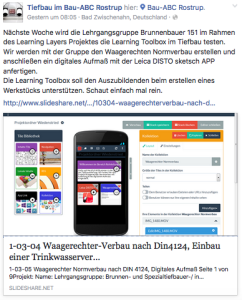Looking back – One year from the Learning Layers meeting in Tallinn
My latest posts on our EU-funded Learning Layers (LL) project have focused on the recent progress with introducing the integrative toolset Learning Toolbox (LTB) to new users in construction sector. Quite suddenly I happened to look at my blog archives and spotted the entries that I had written one year ago. It struck me that at that time we were just having our LL consortium meeting in Tallinn. It is interesting to look, what kind of issues we were discussing at that time as tasks for the near future. And it is even more interesting to see, what all we have been able to implement in practice. Below I will list some of the main points for the construction pilot of the LL project:
1. Multimedia Training concept based on “Theme Rooms”
During preparatory meeting of the construction pilot team the Bau-ABC colleagues presented first time the idea of “Theme Rooms” (see my blog of the 25th of June 2015). In their internal discussions the Bau-ABC trainers had proposed a new format for organising Multimedia Training in consecutive workshops (with ‘virtual rooms’ as support areas). We all got enthusiastic about this idea. Yet, it took some time to put it into practice.
However, in November 2015 we ( = Bau-ABC with support from ITB, Pontydysgu and TLU) managed to implement the first cycle of Theme Room workshops. It involved all Bau-ABC training staff (and the training staff of parallel training centre ABZ Mellendorf) during all Friday afternoons of the November month. As we experienced it, the training campaigned provided important support for the piloting with the Learning Toolbox (LTB) and other LL tools.
2. Making use of Learning Toolbox in Bau-ABC trainers’ projects
In the session on construction pilots we (ITB and Bau-ABC) presented firstly examples of Bau-ABC trainers’ projects that could be supported with LTB. Then, the technical developers presented the functions of the LTB to be expected in the forthcoming beta release. At that time these presentations were two different things. Here again, we needed some time to get ourselves worked in and to organise proper instruction for Bau-ABC trainers.
Looking at the current situation, we have noticed that since the preparation of the kick-off event of LTB pilot (preparation in February 2016, the event itself in March 2016) we have noticed rapid progress. The piloting trainers have soon learned their own ways of creating and linking stacks to organise parallel or consecutive learning activities. Furthermore, they have been able pass their know-how to each other and to learn from each others’ products.
3. Spreading Learning Toolbox to other contexts and new users
For the Tallinn meeting we (ITB, Bau-ABC and Agentur) had prepared posters with which we visualised the exploitation landscapes in which we will be working with spin-off projects for which we expected funding decisions in a short while. Now, looking at the present situation we can give the following update:
- The project DigiProB (digital support for continuing vocational training – construction site managers) has started recently. The stakeholder interviews give points of orientation for introducing LTB and complementary tools in the next phase.
- The regional implementation of the transnational mobility scheme Mobipro-EU is bringing to Germany the second cohort of apprentices from Spain (to be trained in construction companies during the next 3-3,5 years). Some apprentices of the first cohort have participated in an LTB-workshop and support the shaping of specific stacks to support the new group of apprentices (50 persons arriving in July 2016).
- The projects NaBus and DieDa (with focus on ecological construction work) have started and are looking forward to introduce LTB in their training programmes (scheduled for Autumn 2016). Here they can use as points of reference the stacks prepared for the ‘Learning exhibition’ in Verden and the prototype stacks for presenting LTB to member companies of the Netzwerk Nachhaltiges Bauen (NNB).
- The project HAKS (promoting the theme energy-efficiency in vocational education and training) has started and is looking forward to introduce LTB in the next phase of its training activities (also in Autumn 2016).
4. Making use of AchSo and SoAR in the training of Bau-ABC
In Tallinn meeting the team of Aalto University presented two tools. With the video annotation tool AchSo they had already proceeded to field pilots in Finnish construction sector. With the Social Augmented Reality (SoAR) tool they were still in the initial steps. With AchSo they had only provided Android versions and there issues regarding the integration with LTB. Therefore, our impression was that some time will be needed before they can be introduced to the German pilot sites.
Now we have just experienced a three-day event during which the Aalto colleagues have introduced AchSo to two groups of apprentices (and their trainers) and SoAR to the latter group. All events proved to be successful and the apprentices and trainers are looking forward to next steps. For a wider deployment of AchSo the Aalto colleagues are working with the export function of AchSo to be able to use the tool with ordinary videos. (This step is most welcomed by the above mentioned spin-off projects.)
– – –
I think this is enough to show what kind of progress we have made with the LL construction pilot since the Tallinn consortium meeting one year ago. We know that we still have work to do, but can clearly build on our achievements.
More blogs to come …

